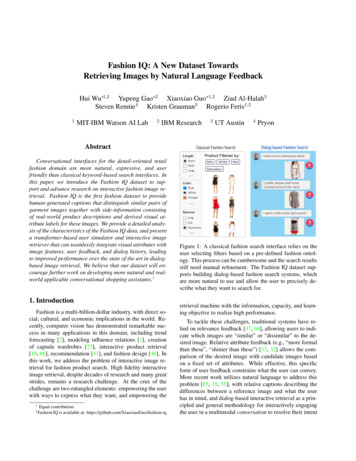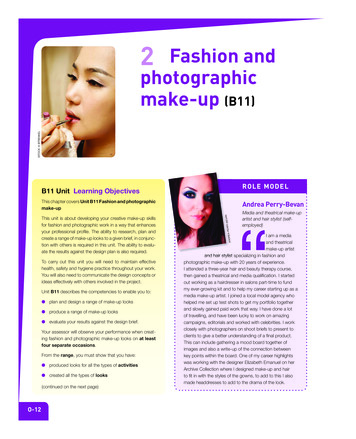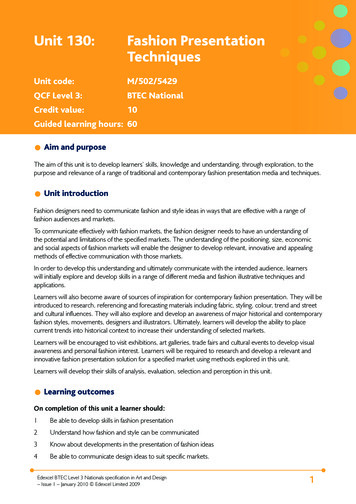
Transcription
Sustainable FashionA Generation Z PerspectiveBACHELOR THESIS WITHIN: Business AdministrationNUMBER OF CREDITS: 15 ECTSPROGRAMME OF STUDY: Marketing ManagementAUTHORS: Fanny Berthem & Madeleine MahrsJÖNKÖPING 05, 2022
Bachelor Thesis Project in Business AdministrationTitle: Sustainable Fashion – A Generation Z PerspectiveAuthors: Fanny Berthem & Madeleine MahrsTutor: Nadia ArshadDate: 2022-05-18Key terms: Sustainable Fashion, Gen Z, Consumer Attitudes, Consumer Behaviour, Theoryof Planned BehaviourAbstractBackground: Increased awareness of the climate crisis leads to sustainability becoming moreimportant to many people as the actions made today will have a large impact on futuregenerations. Generation Z is soon to be the largest consumer group globally, where most peopleare interested in implementing sustainable lifestyles. Gen Z will soon hold a powerful positionas fashion consumers and has the ability to drive positive changes for societies globally.Purpose: The purpose of this research is to study consumer attitudes and behaviour towardspurchasing sustainable fashion products on the Swedish market. The group aimed to be studiedincludes people over the age of 18 in Sweden that belong to generational cohort Z.Method: The method used for this research is exploratory, taking on an inductive approachand collecting qualitative data through 10 semi-structured interviews with people between theages of 18-27 in Sweden. The findings from the data emerged from thematic analysis.Conclusion: The results show that there is a genuine concern for the climate and the future ofthe planet among the cohort, which also has an impact on the attitude. Despite the positiveattitude towards purchasing sustainable fashion products, there is an existing gap between thepositive attitude and consumer behaviour. The accumulated value from factors such as price,style, and availability is often higher than the sole value of an item’s sustainability factor.1
AcknowledgementsBefore presenting this research, we would like to express gratitude to our tutor Nadia Arshadfor all the support, feedback, and valuable lessons she has taught us. Thanks to her guidance,we have developed as researchers during this thesis journey and can proudly present our work.we would also like to thank our ten interview participants, who took their time to help uscomplete this research and answer our questions. Hearing their thoughts and opinions providedinvaluable insights for this research and helped us to gain a deeper understanding of sustainablepurchasing behaviour.In addition, we want to express our gratitude to colleagues and seminar group members, whohave helped us complete this task by reading our drafts and giving us valuable feedback.Finally, we would like to thank our friends and families for always being our biggestsupporters, encouraging and lifting us up when doubting ourselves.Fanny BerthemMadeleine Mahrs2
Table of em61.3.Research Purpose and Research Question71.4.Definitions8Literature Review92.1.Method of Constructing the Literature Review2.2.Definition of Gen Z102.3.Fashion and Its Significance for Gen Z1192.3.1.Sustainable Fashion122.3.2.Fast Fashion132.4.Brand Loyalty132.5.Theory of Planned Behaviour142.6.Synthesis of the Literature Review15Methodology173.1.Research Paradigm173.2.Research Approach183.3.Research Design183.3.1.Method of Data Collection183.3.2.Sample Procedure193.3.3.Interviews213.3.4.Method of Data Analysis223.3.4.1.3.4.4.5Investigator Triangulation26Ethical 7Findings4.1.29Positive Attitude but Conflicting Behaviour294.1.1.Unison Climate Concern304.1.2.Obstacle for Sustainable Purchasing Decisions314.2.Education of Sustainable Fashion and Accessibility in the Society4.2.1.Awareness Exists but Sustainable Fashion is Not Accessible Enough33233
4.2.2.4.3.35The Will to Change for a Better Future394.3.1.Wish to Be Guided Towards Sustainability394.3.2.Sustainability Should be Beneficial404.4.5.Social Image and IdentitySynthesis of the Findings42Analysis445.1.Positive Attitude but Conflicting Behaviour445.2.Education of Sustainable Fashion and Accessibility in the Society455.3.The Will to Change for a Better Future475.4.Sustainable al Implications537.2.Managerial Implications537.3.Limitations547.4.Future Research548.References569.Appendices65Appendix 165Figures and TablesFigure 1: Theory of Planned Behaviour . 15Figure 2: Themes, categories, and aggregate dimensions of data collection . 25Figure 3: Positive attitude but conflicting behaviour . 29Figure 4: Unison climate concern . 30Figure 5: Obstacle for sustainable purchasing decisions . 31Figure 6: Education of sustainable fashion and accessibility in the society. 33Figure 7: Awareness exists, but sustainable fashion is not accessible enough. 33Figure 8: Social image and identity . 35Figure 9: The will to change for a better future . 39Figure 10: Wish to be guided towards sustainability . 39Figure 11: Sustainability should be beneficial . 40Figure 12: Framework of sustainable choices . 49Table 1: Sample . 204
1. IntroductionThe first chapter introduces the background and problem of the study, introducing generationZ and the significance of fashion and sustainability to the cohort. This is followed by theresearch purpose and the two research questions aimed to be answered in the study. Thechapter ends with a list of definitions.1.1.BackgroundIn a constantly and rapidly evolving society, digitalisation enables globalisation in manycontexts and aspects of people’s daily lives. Scientists along with climate activists have beenincreasingly successful in raising global awareness of the current human-made climate crisisthat negatively affects the world; a crisis that partly is caused by overconsumption andunsustainable lifestyles (Hess, 2021). The increased awareness of the climate crisis leads tosustainability becoming more important to many people (Parzonko et al., 2021), and thesocietal challenge that has emerged from the climate crisis today will have a large impact onfuture generations.Generations are often grouped and characterised by various factors and based ondifferent societal challenges they are facing (Djafarova & Bowes, 2021). Generation Z (GenZ) can be defined as the first global generation that was born digital and that is technologydependent (Johnston, 2018). The cohort consists of people born between 1995 and 2010 (Ismailet al., 2021) and is soon to be the largest consumer group globally, where most people areinterested in implementing sustainable lifestyles (Dabija & Bejan, 2017).The generation, which is characterised by technology dependence and technologyconfidence (Johnston, 2018), has a large presence on social media platforms, where people arepresenting their social identities, styles, and personalities through visual content, as well asbeing influenced by other people’s visual content (Djafarova & Bowes, 2021).Fashion is often seen as an important part of defining a person’s personality, creating asocial image, helping the person identify with a specific social group, as well as working as ameans of self-expression (Khare, 2014). Fashion, and especially fast fashion, is a ground fordebate in regard to the ongoing climate crisis. The fast-fashion apparel industry producesgarments of low quality made from unsustainable materials, in low-wage countries withpotentially unethical practices; the fast fashion is then offered to the mass market at a low cost5
to consumers (Abrahamson, 2011; Magnuson et al., 2017). The business model, which is basedon a high consumption and short product life cycle, works as a great source of revenue andprofit for brands due to the idea of frequently replenishing inventory and introducing variousnew styles to encourage customers to buy new garments often, but it has a negative impact onthe climate and environment (Long & Nasiry, 2022).1.2.ProblemThe negative impact that fast fashion has on the environment has become widely recognisedamong Gen Z, as the generational cohort shows strong values regarding environmental issuesand a concern for the challenges that future generations and the planet will have to endure dueto the consequences of their own and older generations’ consumption (Djafarova & Foots,2022). Gen Z represents the largest generation of today (Spitznagel, 2020) and the people ofthe cohort will soon hold a powerful position as fashion consumers and thus have the ability todrive positive changes for societies globally (Hess, 2021); therefore, it is relevant to study thisgenerational cohort. Furthermore, the global awareness and recognition of the need forsustainable fashion among Gen Z has a large impact on decision-making and consumerbehaviour (Parzonko et al., 2021). Hence, this study aims at exploring the group’s attitudes andconsumer behaviour in regard to sustainable fashion in the Swedish market, through the lensof planned behaviour.Sweden as a market is relevant to study as it is often depicted as one of the world’s mostsustainable countries (Robeco, 2021). For example, non-profit organisation Håll Sverige Rent(n.d.) collaborates with schools, companies, and municipalities in Sweden to raise awarenessabout littering and fight the problem in society. In addition, Swedish children are taught aboutsustainability and sustainable development in school from a young age (Skolverket, 2022).Sustainability is also an important factor for higher level education in Sweden. JönköpingUniversity (n.d.) offers the bachelor's program Sustainable Enterprise Development, whichfocuses on environmental and social sustainability. In addition, the university actively workswith sustainability through its sustainability network (Jönköping University, 2021). Accordingto the United Nation’s Development Program (UNDP, 2021) “Agenda 2030”, Sweden is oneof the top countries in reaching the global objectives for sustainable development.Naturally, there are more studies on older generations' attitudes and consumerbehaviour toward sustainable fashion, for example, Gen Z’s predecessor - generation Y, alsoknown as millennials (e.g., Ivanova et al., 2019; Cesarina Mason et al., 2022; Johnstone &6
Lindh, 2018). Nonetheless, existing research on the attitudes and behaviours of Gen Z is scarceand needs to be developed (Lundblad & Davies, 2016), hence a research gap of Gen Zconsumers in Sweden was identified. There are no known studies on Sweden as a consumergroup in this context, and the country’s prominent consciousness regarding sustainabilitycreates the possibility for an empirical study to provide valuable contributions to the field bypresenting implications for marketing managers and creating opportunities for future research.The upcoming parts will present the research purpose and research question, followedby the literature review and methodology. Next, the findings of the research will be displayed,thereafter the analysis and conclusion. Finally, the theoretical implications, managerialimplications, limitations to the study, and suggestions for future research will be explained.1.3.Research Purpose and Research QuestionThe purpose of this research is to study consumer attitudes and behaviour towards purchasingsustainable fashion products on the Swedish market. The group aimed to be studied includespeople over the age of 18 in Sweden that belong to generational cohort Z. The authors aim toexplore this topic through two research questions:RQ1: What is the attitude of generation Z towards purchasing sustainable fashion productson the Swedish market?RQ2: How does generation Z behave towards purchasing sustainable fashion products on theSwedish market?7
1.4.DefinitionsThis list presents definitions that are central to the research.8
2. Literature ReviewThe second chapter establishes the background that has led to an understanding of the existingliterature in the investigated subject, forming the base for the in-depth review, critique, andsynthesis. Consequently, the research gap identified as generation Z on the Swedish market ispresented.2.1.Method of Constructing the Literature ReviewThe literature review which is the base for this research was conducted through an integrativereview approach, where the authors reviewed, critiqued, and synthesised relevant literature inan integrated manner, with the purpose of creating new perspectives and frameworks for thetopic (Torraco, 2016). To ensure high quality and trustworthiness in the literature review, themain body of it consists of peer-reviewed articles and academic books. The literature wasobtained through the databases Jönköping University Primo, Scopus, and Web of Science. Thekeywords which were first used for the search of relevant literature were: “sustainable fashion”,“gen Z OR generation Z”, and “theory of planned behaviour”. When these keywords wereapplied alone, the search was extensive, with more than 100 000 articles found. Thus, to narrowdown the number of articles in the search, additional keywords were used in combination withthe previously presented ones: “consumer attitudes OR customer attitudes”, “consumerbehaviour OR customer behaviour”, “Sweden OR Sverige”. Very little previous research hasbeen made in the context of the theory of planned behaviour for Gen Z in regard to sustainablefashion products, and hence, to facilitate the creation of an integrative literature review,additional, relevant literature was obtained through peer-reviewed articles’ reference lists. Thismethod of finding relevant articles was appropriate as the databases alone did not providesufficient literature for the review.As the study had an inductive, explorative approach, the literature review wasdeveloped further during the data collection process, as new concepts arose from the interviewparticipants that were relevant to the development of theory, namely brand loyalty and secondhand apparel as a sustainable option for purchasing fashion (Collis & Hussey, 2014).9
2.2.Definition of Gen ZWhen speaking of Gen Z, it is not always clear who should be included in the generationalcohort and who should not, as existing research is not in unison regarding which age range GenZ belongs to. According to Priporas et al. (2020), Gen Z are defined as people born between1995 and 2009. However, Tulgan (2013) argues that Gen Z are people born from 1990 or after,and Ismail et al. (2021) define the generational cohort as people born between 1995 and 2010.When creating a definition of the years for a generational cohort, formative experiences liketechnology and socioeconomic trends are considered (Dimock, 2019; Ismail et al., 2021).Segmentation by generational cohorts is helpful as it enables marketers to address relevantcommunication to people with homogenous values, conceptions of the world, and lifeexperiences (Chillakuri, 2020; Riley & Klein, 2021). When defining the cohort as people bornbetween 1996 and 2010, Gen Z accounts for 32% of the world’s population and is thus thelargest generation today (Spitznagel, 2020). Due to the formative experiences and digital natureof Gen Z, this research was performed by the definition of Gen Z as people born between 1995and 2010 (Ismail et al., 2021).Gen Z can be considered the first global generation, as they were born digital; thegeneration has not experienced a life without the internet and the people are technologydependent in their daily lives (Johnston, 2018). Williams (2015) characterises Gen Z asdiligent, unsettled, and conscious about the future. Hess (2021) describes Gen Z as thegeneration that has the ability to shape politics and cultures; the generation that will makepositive changes for societies globally. Parzonko et al. (2021) argue that the internet lays thefoundation for Gen Z’s consumer behaviour and social values, and Tulgan (2013) claims thatGen Z has high expectations and is likely to openly oppose when in disagreement. It is alsoconsidered to be the generation that will take a lead role in fighting future environmentalchallenges (Parzonko et al, 2021).Gen Z is the cohort where most people are concerned with living sustainable lifestyles(Dabija & Bejan, 2017). Hess (2021) regards climate activist Greta Thunberg, born in 2003, asa prominent figure and example of the generation that to a higher degree than earliergenerations is concerned about showing pro-environmental behaviour (Parzonko et al., 2021).Gen Z is the generation that in a few years will have the overall highest degree of education,compared to older cohorts (Fry & Parker, 2018). This degree of education is an enabler of thecohort’s strong values regarding environmental issues that result in a prominent concern forthe consequences of their own consumption, regarding the state of the planet for future10
generations to come (Djafarova & Foots, 2022). The people of Gen Z have access to globalknowledge due to their technical confidence and large online presence. It is the generation thatis often looking for change and challenge, and the generation that can be driven by impulses(Bencsik et al., 2016; Djafarova & Bowes, 2021; Hess, 2021). According to Seemiller andGrace (2019), Gen Z is the generation that is driven by the will to create sustainable futuresocietal changes and develop viable solutions to global warming; inventions that do notcompromise the quality of life.Attributes that characterise gen Z are speed and impulse, which are important aspectsof their activities. According to Djafarova and Bowes (2021), 41% of consumers in the Gen Zgroup are impulse buyers, compared to antecedent generation Y, where 34% are impulsebuyers. With their digital nature, Gen Z consumers are generally present on social media.Djafarova and Bowes (2021) claim that this generation’s purchase behaviour is influenced bythe content on social media platforms like Instagram, where celebrities or micro-influencersset trends and encourage impulse fashion purchases.2.3.Fashion and Its Significance for Gen ZFashion is often important for young people as a tool to express themselves and theiruniqueness (Djafarova & Bowes, 2021; Vajkai & Zsóka, 2020). Major drivers for people toconsume fashion are to achieve a sense of belonging, increased self-esteem, and becomeaccepted by peers (Belk, 1985; Richins, 1994), and hence how other people in their socialsurroundings perceive them becomes important (Autumn Fair, 2019, as cited in Djafarova &Foots, 2022).Gen Z is concerned about whether fashion is sustainable or positive from anenvironmental perspective. However, in the decision process, factors like price and quality arecrucial and impact the purchase decision; price can even be considered the biggest barrierpreventing consumers from purchasing sustainably (Djafarova & Foots, 2022). A sustainableproduct that has a high price is likely to be dismissed over a cheaper option by Gen Z (Guo etal., 2020). Schroth (2019) suggests that Gen Z has the intention and attitude to engage withfashion brands that are sustainable. However, while the generation shows a positive attitudetowards sustainability, the behaviour is not in line with that attitude (Naderi & Van Steenburg,2018). Sustainable products are most often more expensive, less accessible, and less appealing;thus, Gen Z is likely to perceive a higher value from low costs and accessibility compared tosustainability aspects of the product or service offered (Chen and Chai, 2010; Naderi and Van11
Steenburg, 2018; Lundblad & Davies, 2016; Wiederhold & Martinez, 2018). Djafarova andFoots (2022) argue that, in order to make sustainable fashion a top priority for Gen Z,governmental legislation needs to be implemented.2.3.1.Sustainable FashionThere is no industry standard for the concept of sustainable fashion, and hence the definitionof it is not easily made (Lundblad & Davies, 2016). According to Heinze (2020), sustainablefashion can be described as the use of environmentally friendly materials in the process ofmanufacturing apparel, in combination with transparency in the supply chains. Cervellon et al.(2010) use the term eco-fashion to describe sustainable fashion. Furthermore, the authorspresent sustainable fashion as an umbrella term, including a number of definitions that are usedinterchangeably in the field of sustainable fashion, such as ethical-, organic-, green-, recycled,and re-used fashion. Clark (2008) presents sustainable fashion in terms of slow fashion, inwhich, in addition to producing garments in a slower manner than fast fashion, all aspects ofthe ecosystem are aware of the ecological impact production of garments has. In addition toincorporating the manufacturing and supply chain aspects into the term of sustainable fashion,other factors with regards to consumption should be accounted for, such as use, reuse, anddisposal, as these can have a major impact on the sustainability of a fashion product (Cervellonet al., 2010).In addition to purchasing new, sustainably produced fashion products, consumers candevelop more sustainable consumption behaviours by choosing used, i.e., second-hand fashionclothes. By extending the average life of clothes by 3 months, the environmental impact fromwater and waste can be reduced by 10% (Wrap, 2012). According to Kim et al. (2021),consumers that choose to purchase second-hand garments do so because of the emotional valueit creates, while the biggest risk consumers perceive that can refrain from purchasing secondhand items is the fear of the item being unsanitary. Furthermore, Norum and Norton (2017)claim that the younger generations are more likely to choose to purchase second-hand clothesbut emphasise that purchasing used fashion is often associated with a stigma of inferiority, andcan be related to having a low income. Moreover, second-hand fashion can be consumed toachieve personal economic benefits, for example by purchasing expensive, or luxury fashionfor a cheaper price, as these purchases are viewed as investments (Ramkumar et al., 2021).People purchasing fashion can experience a greater accumulated value from factorssuch as product features, perceived style or appearance, quality, and price, compared with thevalue gained solely from purchasing sustainable fashion products (Beard, 2008). Joergens12
(2006) claims that consumers that perceive a sustainable clothing item’s appearance or style asunappealing would withstand a purchase of sustainable fashion over an appealing fashionclothing item that is not considered sustainable. In addition, Joergens (2006) states that theprice difference between sustainable fashion and not-sustainable fashion also influences theconsumer’s purchase decision.2.3.2.Fast FashionThe fast fashion industry contains short-life-cycled products with affordable prices and is basedon seasonal trends. It satisfies consumers' demand for quality and style while keeping the priceto a minimum and thus reduces the time from production to consumption. However, a highconsumption demands a large production that will test companies' ability to use green solutionsfrom the products’ start point to the end destination, when being purchased by customers(Bruce & Daly, 2006). Consumers buying fast fashion usually have high impulse purchasedecisions and are encouraged to keep garments for a short period of time (Weber et al., 2016).Gen Z is known for believing companies should address these kinds of unsustainableissues, and companies who ignore these issues risk suffering consequences in the future (Amedet al., 2019). A Swedish study proved 21% of young adults dispose of clothing due to a lack ofinterest in the garments. One reason for this type of behaviour is the sensibility among Gen Zfor fashion trends and symbolic consumption (Ekström & Salmonson, 2014). Piacentini andMailer (2004) argue that consumption is devoted to creating your own self but also toexpressing your social group. Younger consumers who usually are in search of these types ofquestions are trying to establish and find an identity or variety of identities through expressionsof clothing.The study by Vajkai and Zsóka (2020) shows that people of Gen Z use apparel toexpress their personality and can avoid a certain fast-fashion brand if that brand is perceivedas unexceptional. Fast fashion brands are also avoided when the quality is perceived as low,although expectations decrease with the price (Vajkai & Zsóka, 2020). The biggest impact ofGen Z’s fast fashion avoidance is moral reasons, which is in line with the sustainabilityconsciousness claimed by Parzonko et al. (2021) and Dabija and Bejan (2017).2.4.Brand LoyaltyBrand loyalty, according to Berkowitz et al., (1978), is based on customers' cognitive processesof favouring a brand over another. Brand loyalty is a biased response, meaning that there must13
be a systematic tendency to purchase a certain product from a group of brands. The choice isdeveloped from the consumer’s earlier experiences and past purchase decisions. Brand loyaltyindicates high satisfaction levels among customers and can work as a tool for creating andmaintaining sustainable competitive advantage (Rosenbaum-Elliott, et al., 2018). However, asthe cost of switching from one brand to another is determined by the individual, loyalty cannever be taken for granted by brands.Strong brand loyalty may create a barrier for new brands to enter a product category onthe market. To be a successful new brand, it is important to be the chosen alternative over yourcompetitors (Rosenbaum-Elliott, et al., 2018), i.e., to offer something that can attractconsumers that are loyal to other brands to consider switching, or create the urge for them totry something new. Aaker (1997) argues that, to make brand loyalty a barrier to new entry in aproduct category, the competitors must understand that high brand loyalty may exist not onlyattitudinally but also behaviourally.(Rosenbaum-Elliott, et al., 2018) state that brand loyalty contributes to stable sales overa long period of time, and those customers that are loyal to a brand are not very price sensitive;a brand with high brand loyalty can usually change their prices, or charge higher prices, withoutthe risk of decreasing their market share or revenue.2.5.Theory of Planned BehaviourIntentions are behaviours that a person plans on performing. Purchase behaviour defines theactions consumers take to buy a product or service. The theory of planned behaviour (TPB)model (Figure 1) uses earlier steps to predict and understand consumers' purchase behaviourbefore performing the purchasing act (Ajzen, 2002).14
Figure 1: Theory of Planned BehaviourTPB can be described as the cognitive accounting of beliefs and valuations (Ajzen, 1991). TheTPB model can be divided into three components of beliefs that can control and explain futurebehavioural intentions. First, subjective norms are the beliefs of approval by others that areconsidered important to an individual or a social group. Second is attitude, which refers topositive or negative experiences of certain behaviour. Third is the perceived behaviouralcontrol, which is the impact of external factors like knowledge and ability (Ajzen, 1985). Thus,these types of valuations can influence differently towards beliefs of sustainability concepts(Valaei & Nikhashemi, 2017). This model improves in explaining the concept of perceivedbehavioural control and when discussing sustainability and other green solutions, individualsmay have strong attitudes and subjective norms towards purchasing sustainable fashion(Hwang & Ok, 2013).The theory is favourable when analysing consumer's pro-environmental behaviours andsustainable consumption in general (Saricam & Okur, 2018). Additionally, Tikir and Lehmann(2011) underline facts such as beliefs together with certain information about specific objects.They claim that a consequence from a behaviour that is influenced by cultural and personalfactors like the personality of the individual can be influential on the beliefs towards specificbehaviour regarding sustainability concepts.2.6.Synthesis of the Literature ReviewExisting literature defines Gen Z as consumers driven by speed and impulse (Bencsik et al.,2016; Djafarova & Bowes, 2021; Hess, 2021), and the will to create societal changes for the15
better, for a more sustainable future for tomorrow’s generations (Seemiller and Grace, 2019).Gen Z is the largest generational cohort of today and has the power to make a difference forfuture generations with its global, digital nature (Spitznagel, 2020). However, despite thepositive attitude towards sustainability and high morals represented by the cohort, identity andexpressing individual uniqueness through apparel is an important aspect characterising thegeneration, through which the consumer behaviour of purchasing fast fashion is prominent(Ekström & Salmonson, 2014). Sustainable fashion is often more expensive and less accessiblecompared to fast fashion, and hence price and availability are factors considered crucial for thepurchase decisi
1 Bachelor Thesis Project in Business Administration Title: Sustainable Fashion - A Generation Z Perspective Authors: Fanny Berthem & Madeleine Mahrs Tutor: Nadia Arshad Date: 2022-05-18 Key terms: Sustainable Fashion, Gen Z, Consumer Attitudes, Consumer Behaviour, Theory of Planned Behaviour Abstract Background: Increased awareness of the climate crisis leads to sustainability becoming more










